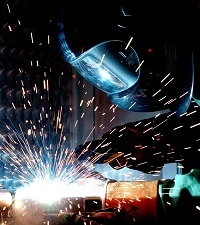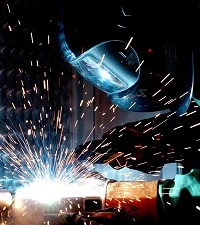Welding is a process of joining two similar or dissimilar metals by fusion. Welding joins the metals/alloys, with or without the application of pressure and with or without the use of fillers metal. The fusion of metals takes place by means of heat. Heat can be generated by the combustion of gases, electric arc, electrical resistance, or chemical reaction. During some types of welding processes, pressure may also be used, but this is not an essential requirement.

Welding is widely used in manufacturing and service processes industries. Some typical applications of welding include:
- Shipbuilding
- Pressure vessel
- Automobile body
- Offshore platform
- Bridge
- Military
- Sealing of pipelines
- Nuclear fuel and explosives, etc.
Most metals and alloys can be welded by one type of welding process or another. However, some are easier to solder than others. To compare this feature in the duration of welding the term “weldability” is often used.
Weldability
Weldability can be defined as the property of a metal that indicates the ease with which it can be welded with other similar or dissimilar metals. The weldability of a material depends on various factors such as metallurgical changes caused by welding, changes in hardness in and around the weld, evolution, and absorption of gas, the degree of oxidation, and the effect on the tendency to fracture of the joint.
Plain low-carbon steel (C-0.12%) has the best weldability among metals. It is generally seen that the material with high castability usually comes with low weldability.
Terminology used in Welding Process
Welding process terminology is used with common terms such as the base metal, fusion zone, weld face, and root face.
Edge Preparation
For welding, the edges of the surfaces to be joined are first prepared. Various edge preparations can be used to weld butt joints.
Welding Joints
Welding joints are generally two types These are Lap joint and Butt Joint. We will discuss each of them one by one.
Butt Joint
Single-Vee Butt Weld
A single V butt weld joint is used for plates of a thickness up to 15.8 mm. The joining plates are spaced at approximately 3.2 mm.
Double-Vee Butt Weld
A Double-Vee Butt Weld is used for plates which is having a thickness of over 13 mm and the welding can be done on both sides of the plate. The top vee angle is either 60° or 80°, while the bottom angle is 80°.
Lap Joint
Single-Lap Joint
Single-Lap Joint is made by overlapping the edges of the plate. The single lap joint is not having much strength. It can be used satisfactorily for joining two cylinders that fit inside one another.
Double-Lap Joint
Double-Lap Joint is stronger than the single-lap joint but has the disadvantage that it requires double welding.
Welding Positions
There are four types of welding positions which are given below:
- Flat or Down Weld Position
- Horizontal welding position
- Vertical Welding Position
- Overhead welding position
Flat or Down Weld Position
Flat position or hand-down position is one in which the weld is made at top of the joint and the weld face are nearly horizontal. it is the easiest and most convenient position for welding. Using this technique, excellent welding joints and high-speed joints can be made with minimal risk of welder fatigue.
Horizontal welding position
In the horizontal position, the plane of the workpiece is perpendicular and the deposited weld head is horizontal. The metal deposition rate in horizontal welding is close to the rate achieved in flat welding.
or below welding position. This welding position is most commonly used in welding Containers.
Vertical Welding Position
In the vertical position, the plane of the part is vertical and the weld is deposited over the vertical surface.
It is difficult to produce a satisfactory weld in this position because of the vertical surface effect due to the force of gravity on the molten metal. The welder must constantly monitor the metal. So it doesn’t move or fall off the welder. Vertical welding can be of two types, namely, vertical up and vertical down. Vertical up welding is preferred when strength is most important. Vertical down welding is used for sealing operations and sheet metal welding.
Overhead Welding Position
The top position is probably even more difficult to weld than the vertical position. Here the gravitational force towards the molten metal is very strong.
ADVANTAGES AND DISADVANTAGES OF WELDING
Advantages of Welding
- Welding is a cheaper and much faster process than others (riveted, screwed, cast, etc.)
- Welding, if properly handled, results in a permanent bond with a strength equal to or greater than more than the base metal.
- A large number of metals and alloys, both similar and dissimilar, can be joined by welding.
- General welding equipment is not very expensive.
- Portable welding equipment may be readily available.
- Allows considerable freedom in welding design.
Disadvantages of Welding
- It results in residual stress and deformation of workpieces.
- The welded joint requires stress relief and heat treatment.
- Welding emits harmful radiation (light), fumes, and splashes.
- Jigs and fixtures may also be required to hold and position the parts to be welded.
- Edge preparation of welding works is essential before welding.
- Producing a good weld requires a skilled welder.
- The heat during welding produces metallurgical changes in the structure of the weld.
FAQ
What is Welding?
Welding is a process of joining two similar or dissimilar metals by fusion. Welding joins the metals/alloys, with or without the application of pressure and with or without the use of fillers metal.
Also Read Moulding sand and its properties
